Contents
- 1 1. Introduction to Setting Up Price Alerts for Flights
- 2 2. What Are Price Alerts for Flights?
- 3 3. Benefits of Using Price Alerts for Flights
- 4 4. Popular Platforms to Set Up Price Alerts for Flights
- 5 5. How to Set Up Price Alerts for Flights Step-by-Step
- 6 6. Best Practices When Setting Up Price Alerts for Flights
- 7 7. Understanding Flight Price Trends and Patterns
- 8 8. Combining Price Alerts with Other Flight Booking Tips
- 9 9. Troubleshooting Common Issues with Price Alerts
- 10 10. Advanced Tips for Power Users
- 11 11. Real-Life Success Stories Using Price Alerts
- 12 12. Comparing Price Alerts to Other Flight Deal Strategies
- 13 13. How to Stay Updated on Flight Price Alert Innovations
- 14 14. Understanding the Limitations of Price Alerts for Flights
- 15 15. Ethical Considerations and Privacy When Using Price Alert Tools
- 16 16. How to Set Up Price Alerts for Flights on Mobile Devices
- 17 17. Integrating Price Alerts with Loyalty Programs and Miles
- 18 18. Planning Group Travel Using Price Alerts for Flights
- 19 19. Conclusion: Mastering Price Alerts for Flights to Travel Smarter
- 20 Everything you want to know, answered below
- 20.1 u003cstrongu003e How Often Do Flight Prices Change?u003c/strongu003e
- 20.2 u003cstrongu003eCan Price Alerts Guarantee the Lowest Fare?u003c/strongu003e
- 20.3 u003cstrongu003e Are Price Alerts Free to Use?u003c/strongu003e
- 20.4 u003cstrongu003eWhat If I Miss an Alert?u003c/strongu003e
- 20.5 u003cstrongu003eCan I Set Alerts for Flexible Dates?u003c/strongu003e
- 20.6 u003cstrongu003e Do Price Alerts Work for International Flights?u003c/strongu003e
- 20.7 How to set flight price alerts on Kiwi.com
- 20.8 u003cstrongu003eDo flight alerts really help you save money?u003c/strongu003e
- 20.9 u003cstrongu003eAviasales flight alerts vs Trip.com flight alertsu003c/strongu003e
- 20.10 Can I set up flight alerts for multiple destinations?
- 20.11 Flight alert tips to find last-minute travel deals
- 20.12 What is the best tool for monitoring airfare drops?
1. Introduction to Setting Up Price Alerts for Flights

1.1 Why Price Alerts for Flights Are a Must for Smart Travelers
Price alerts for flights are a game-changer. If you’re tired of watching fares bounce around like a yo-yo, you need alerts. These tools keep an eye on ticket prices, so you don’t have to. As soon as there’s a drop, you get notified. Simple. Smart. Essential.
If you’re ready to get started, check out these trusted tools like Kiwi.com, Trip.com, and WayAway that make setting up price alerts for flights fast and simple
1.2 How Price Alerts Help You Find the Cheapest Flights Fast
Instead of checking flights every day, set a flight price alert and let the price tracking tool do the work. The system scans updates in real-time and pings you the moment there’s a deal, ensuring you’re first in line when flight prices drop, especially on competitive routes. For more strategies, see our guide on mastering price alerts for flights.
2. What Are Price Alerts for Flights?
2.1 Understanding Flight Price Tracking Tools
Flight tracking tools, like those from Trip.com or Kiwi.com, utilize a flight price tracker to scan airfares from hundreds of airlines. They monitor price changes and send immediate alerts when there’s a drop in the cost of specific flights.
2.2 How Airlines and Travel Sites Use Dynamic Pricing
Airline pricing is wild, with fares fluctuating due to factors like demand, booking time, and route popularity, a phenomenon known as dynamic pricing. Many travelers utilize a flight price tracker to monitor price changes and receive alerts for specific flights from airlines like Delta and Emirates. If you want to discover more about flying cheaply on these routes, explore our Low Budget Airlines Guide.
3. Benefits of Using Price Alerts for Flights
3.1 Save Money on Your Next Trip
You don’t have to be a frequent flyer to save big on airfare. A simple flight price alert can help you catch a fare drop that others miss, often saving $50, $100, or even $300. For more advice, visit our page on finding low budget flights.
3.2 Avoid Last-Minute Price Surges
Ticket prices often skyrocket just before the departure date, but using a flight price alert can help you track flight pricing and lock in deals early, no surprises.
3.3 Get Notified About Flash Sales and Discounts
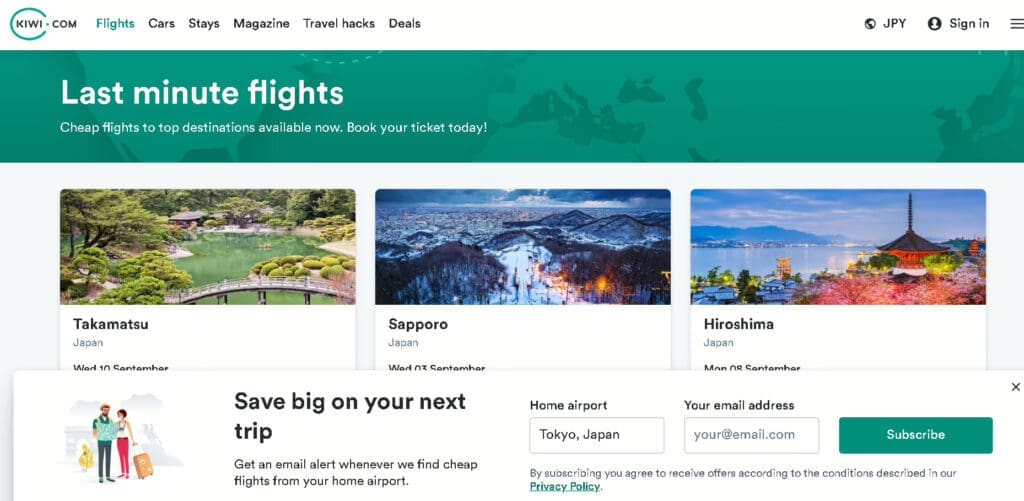
Airlines love unannounced flash sales, and they go fast. Utilizing a flight price alert ensures you’re one of the first to know when airfare suddenly becomes more affordable. Read more in our article on the ways to master price alerts for flights.
4. Popular Platforms to Set Up Price Alerts for Flights
4.1 Kiwi.com – Smart Routing and Price Predictions
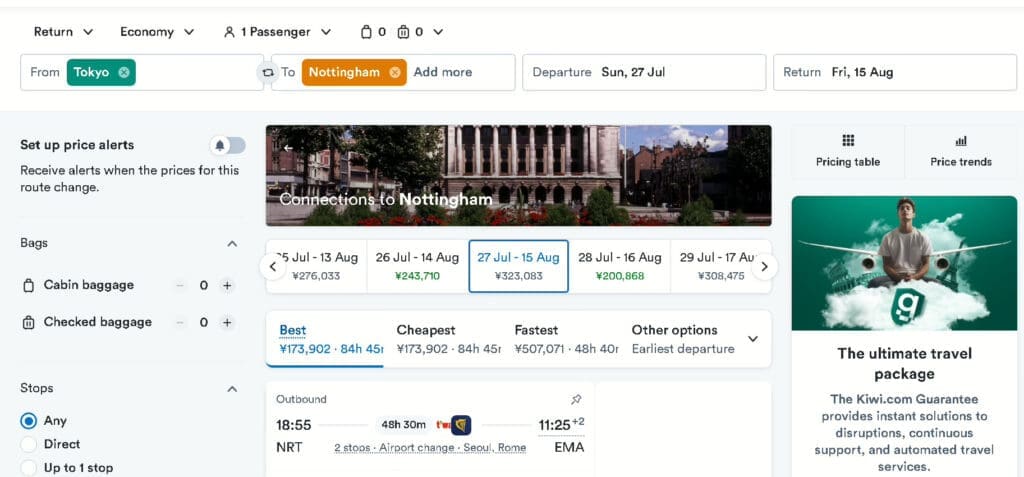
Kiwi.com provides a flight price alert feature that allows you to set detailed alerts and build custom multi-city trips, while its price-prediction engine helps you book flights at the right time without overpaying.
4.2 Trip.com – Global Reach with Regional Deals
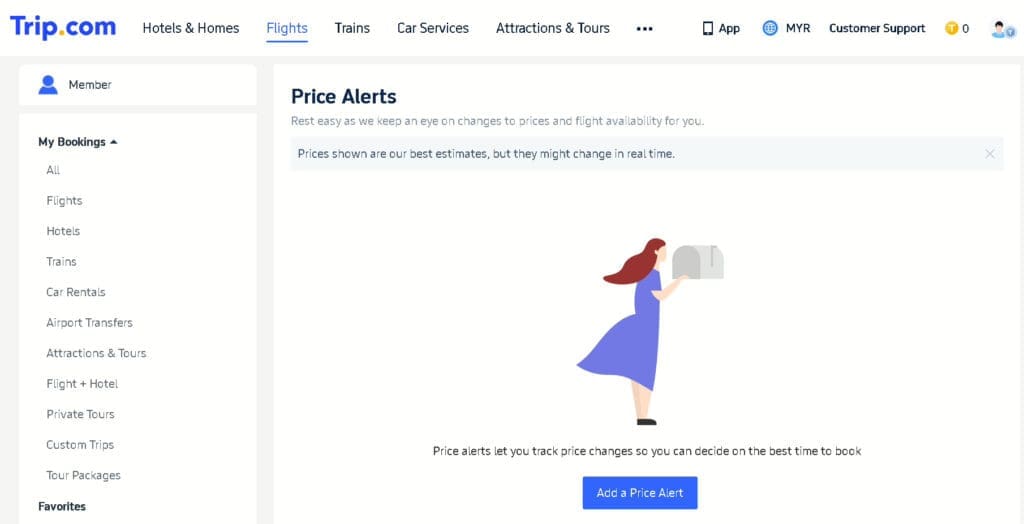
Use Trip.com to monitor prices across Asia, Europe, and beyond. It offers powerful alerts and loyalty rewards all in one place.
Click here to learn in detail about the loyalty program.
4.3 WayAway – Price Alerts with Cashback Perks
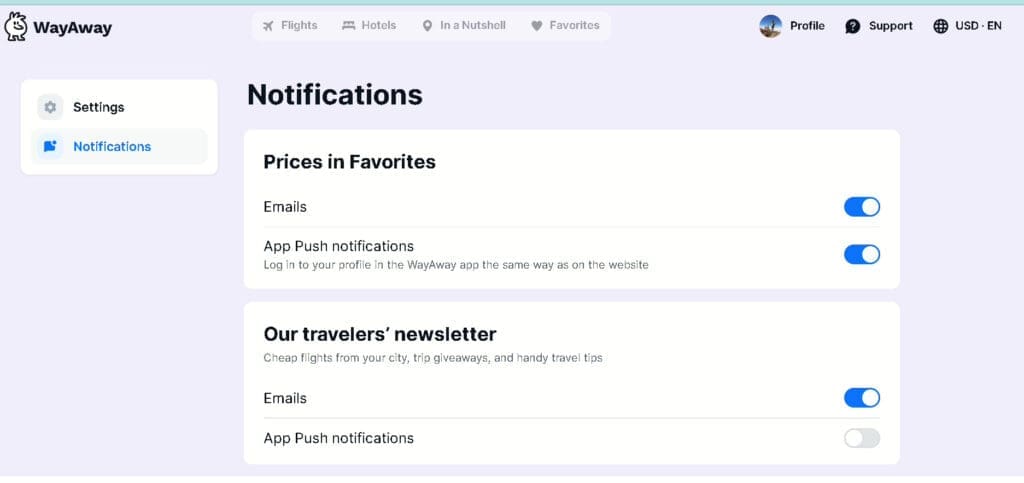
WayAway gives you more than alerts—it offers cashback on your bookings, making every fare drop even more rewarding.
Check here to know in detail about the cashback.
4.4 Google Flights: Easy and Free Flight Price Alerts
Google Flights is simple. Search your flight route, toggle the ‘Track prices’ button, and you’ll receive email notifications for flight price alerts.
4.5 Skyscanner Price Alerts: Track Deals Worldwide
Skyscanner covers airlines and booking sites around the world. You can set alerts for specific dates or flexible ones. For more worldwide booking strategies, see our Worldwide Travel Guide.
5. How to Set Up Price Alerts for Flights Step-by-Step
5.1 Creating an Account on Flight Search Engines
Most platforms need a free account. It helps track alerts, manage preferences, and send notifications.
5.2 Choosing Your Preferred Routes and Dates
Be specific with your flight options by selecting your origin, destination, and travel dates, or utilize a flight price tracker for the best deal.
5.3 Activating Notifications on Mobile and Email
Turn on flight price alerts in your settings. Use both email and push notifications to track flight pricing updates.
5.4 Customizing Alerts for Flexible Dates and Airports
Want to fly anytime in March or out of any New York airport? Use a flight price alert tool for broader savings.
6. Best Practices When Setting Up Price Alerts for Flights
6.1 Setting Realistic Price Thresholds
Don’t expect a $600 flight to drop to $100; instead, use a flight price tracker to research average airfare prices and spot real deals.
6.2 Tracking Multiple Routes Without Getting Overwhelmed
Limit yourself to 3-5 flight price alerts at a time. This way, your inbox won’t get flooded, and you’ll stay focused on tracking flight pricing. Our budget travel tips can also help you narrow destinations.
6.3 Timing Your Alerts for Seasonal and Holiday Travel
Set alerts early—3-6 months in advance—for peak seasons like Christmas or summer vacations. For advice, check out the low budget airlines guide.
7. Understanding Flight Price Trends and Patterns
7.1 When Do Flight Prices Usually Drop?
Midweek, particularly Tuesday and Wednesday, serves as a sweet spot for many travelers seeking to book flights, as most sales are launched early in the week and tend to fill up quickly. Learn more tricks in our price alerts guide.
7.2 The Role of Airlines Like Delta, American Airlines, and Emirates
Major carriers adjust airfare based on competitor moves, weather, and booking patterns, making flight price alerts essential for catching short-lived deals.
7.3 How Events and Holidays Affect Flight Prices
Concerts, festivals, and holidays like Thanksgiving or Eid spike demand; using a flight price alert can help you plan around them.
8. Combining Price Alerts with Other Flight Booking Tips
8.1 Using Incognito Mode and Clearing Cookies
Concerts, festivals, and holidays like Thanksgiving or Eid spike demand; using a flight price alert can help you plan around them.
8.2 Booking Midweek vs. Weekend Flights
Tuesdays and Wednesdays are often the cheapest days to book flights, while Saturdays and Sundays typically see airfare increases.
8.3 Taking Advantage of Budget Airlines Like Ryanair and Southwest
Set flight price alerts for low-cost carriers; they often fly odd hours, offering unbeatable airfare deals. See our budget airlines guide for more tips.
9. Troubleshooting Common Issues with Price Alerts
9.1 Not Receiving Alerts? What to Check
Check spam folders for flight price alerts and ensure your email notifications are updated.
9.2 Managing Multiple Alerts Without Confusion
Label or categorize your flight price alerts by destination or travel dates, and regularly clean up old alerts.
9.3 Dealing with Price Alert Expirations and Renewals
Some alerts auto-expire after 30 days. Renew them manually if your travel plans are still open.
10. Advanced Tips for Power Users
10.1 Using APIs and Third-Party Tools for Flight Price Monitoring
For the tech-savvy, APIs like Skyscanner’s and Kiwi.com’s let you create custom flight trackers that monitor flight price patterns. These tools can scan routes, dates, and even fare classes, providing immediate alerts on airfare changes.
10.2 Integrating Alerts with Travel Planning Apps
Apps like TripIt and Google Trips can sync your travel plans. When connected to your flight price alert tools, they help align airfare deals with your actual itinerary—no overlap, no surprises..
10.3 Leveraging Social Media for Exclusive Flight Deals
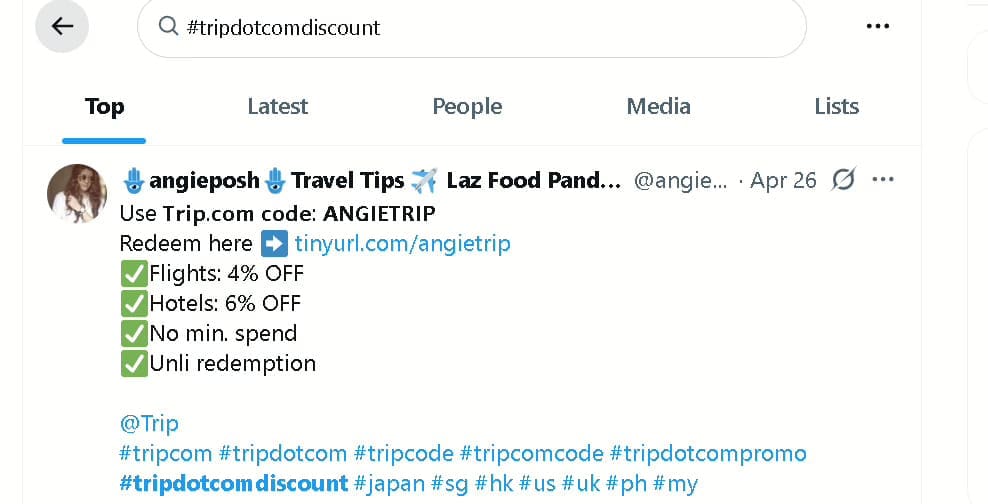
Follow airlines and deal-finder accounts on X (formerly Twitter), Instagram, or Facebook. They often post promo codes and flash sales not found elsewhere. Combine this with your alerts for double the savings. For more inspiration, review our budget travel blog.
Trip.com:X(Twitter)
11. Real-Life Success Stories Using Price Alerts
11.1 How Travelers Saved Hundreds on Transatlantic Flights
A New York-based couple scored $370 round-trip tickets to Paris thanks to a flight price alert from Google Flights. They quickly booked their tickets within minutes of the price drop, avoiding the nearly $800 airfare. If you want more inspiration, see the New York travel guide.
11.2 Best Last-Minute Deals Caught with Alerts
A solo traveler from San Francisco utilized Hopper’s flight price alert feature to secure a last-minute $150 flight to Hawaii. The app’s AI suggested a one-day wait, and that’s when the price drop alert came through.
12. Comparing Price Alerts to Other Flight Deal Strategies
12.1 Email Newsletters vs. Price Alerts
Newsletters like Scott’s Cheap Flights offer curated deals, often hand-picked. However, using a flight price alert tool provides automated notifications tailored to your specific flights, giving you more control over your next flight purchase.
12.2 Flash Sale Websites vs. Automated Alerts
Flash sale sites like Secret Flying or Airfarewatchdog highlight sudden discounts, but flight price alert tools notify you in real-time, often faster than these sites update.
13. How to Stay Updated on Flight Price Alert Innovations
13.1 Latest AI Developments in Price Prediction
Companies like Trip.com and Google are investing heavily in AI to better predict airfare trends. These systems analyze flight price history, events, and booking trends to forecast when to book flights.
13.2 Emerging Flight Search Engines with Alerts
New players like Flyline and FareDrop provide a flight price tracker with enhanced tracking, premium features, and unique deals, especially for niche or long-haul routes. To see how other travelers maximize budget tools, read about mastering price alerts for flights.
14. Understanding the Limitations of Price Alerts for Flights
14.1 When Price Alerts Might Not Work
If you’re booking last-minute or during a high-demand event, a flight price alert may not find cheaper options, as prices can remain high.
14.2 The Impact of Airline Policies
Refund rules, seat availability, and travel restrictions still affect airfare pricing. Flight price alerts don’t always catch policy changes, so double-check before booking.
15. Ethical Considerations and Privacy When Using Price Alert Tools
15.1 How Your Data Is Used by Flight Search Engines
Sites may track your behavior to personalize offers and utilize a flight price tracker to provide price predictions for specific flights. Some sell this data to third parties, so always read the privacy policy.
15.2 Protecting Your Privacy While Tracking Flight Prices
Use strong passwords and consider using apps that don’t store personal information long-term while tracking flight pricing.
16. How to Set Up Price Alerts for Flights on Mobile Devices
16.1 Best Flight Alert Apps for iOS and Android
Start by signing up on Kiwi.com or Trip.com to access their flight price alert tools and personalized tracking.
16.2 Managing Notifications to Avoid Overload
Turn off alerts for routes you no longer need. Use in-app settings to control how often you’re pinged and what’s prioritized. For tips on managing multiple alerts, check our step-by-step price alerts guide.
17. Integrating Price Alerts with Loyalty Programs and Miles
17.1 Using Alerts to Maximize Frequent Flyer Rewards
Track both cash fares and award availability. Set alerts when point redemption costs drop for routes with airlines like Delta, Emirates, or Lufthansa.
17.2 Tracking Award Ticket Prices
Use sites like Point.me or AwardHacker to pair price alerts with point-based flight searches. Maximize every mile you’ve earned. For more on maximizing your travel, see our page about Travel Tips.
18. Planning Group Travel Using Price Alerts for Flights
18.1 Coordinating Alerts Across Multiple Travelers
Use shared accounts or create a spreadsheet with alerts and timelines. Platforms like Skyscanner let you track for a group under one account. For more group travel guidance, check out our article on traveling like locals.
18.2 Finding Deals for Families and Groups
Budget airlines often have limited seats at low prices. Alerts help you snag group deals before prices rise with each booked seat. For more tips on saving money, explore our guide to finding low budget flights.
19. Conclusion: Mastering Price Alerts for Flights to Travel Smarter

19.1 Recap of Key Steps to Set Up Price Alerts
Start with a flight search engine you trust. Create an account, set up alerts, choose your routes, and watch the deals come in. Stay flexible, use both apps and desktop platforms, and manage alerts smartly. If you need a refresher, review our step-by-step price alert guide.
19.2 Encouragement to Start Using Price Alerts Today
Why overpay when you don’t have to? Price alerts for flights make traveling affordable, stress-free, and surprisingly fun. Set yours up today and start saving on every trip. Get started today with tools like Kiwi.com, Trip.com, or WayAway. Set your alerts, grab the deals, and enjoy your journey. For more tips on affordable travel, check out our budget travel blog.
Everything you want to know, answered below
u003cstrongu003e How Often Do Flight Prices Change?u003c/strongu003e
Prices can change several times a day. That’s why alerts are critical—they catch the drop when it happens.
u003cstrongu003eCan Price Alerts Guarantee the Lowest Fare?u003c/strongu003e
No guarantee, but they give you a strong edge. Combine alerts with good timing for the best shot at low fares.
u003cstrongu003e Are Price Alerts Free to Use?u003c/strongu003e
Most platforms offer free alerts. Some, like FareDrop Pro, charge for premium features like error fare detection.
u003cstrongu003eWhat If I Miss an Alert?u003c/strongu003e
Set up multiple channels—email, push, SMS—so you never miss out. Check alerts quickly; the best deals disappear fast.
u003cstrongu003eCan I Set Alerts for Flexible Dates?u003c/strongu003e
Yes. Google Flights, Skyscanner, and Kayak let you set alerts for entire months or multiple days.
u003cstrongu003e Do Price Alerts Work for International Flights?u003c/strongu003e
Absolutely. International routes often have bigger swings, perfect for tracking major savings.
How to set flight price alerts on Kiwi.com
Go to u003ca href=u0022https://kiwi.tpo.li/oZC9EHgHu0022u003eKiwi.comu003c/au003e, enter your route, and toggle the price alert option. You’ll get email updates when fares change.
u003cstrongu003eDo flight alerts really help you save money?u003c/strongu003e
Yes. Flight alerts help you catch price drops you’d likely miss. They increase your chance of booking at the best rate.u003cbru003e
u003cstrongu003eAviasales flight alerts vs Trip.com flight alertsu003c/strongu003e
u003ca href=u0022https://aviasales.tpo.li/4lsodAxbu0022u003eAviasalesu003c/au003e offers flexible region-wide tracking and budget filters. u003ca href=u0022https://trip.tpo.li/Ev5PFusTu0022u003eTrip.comu003c/au003e is user-friendly, especially for booking multi-city routes. Both are reliable for finding deals.u003cbru003e
Can I set up flight alerts for multiple destinations?
Yes. Most platforms let you set multiple alerts at once. Great for flexible travelers exploring options.
Flight alert tips to find last-minute travel deals
What is the best tool for monitoring airfare drops?
u003ca href=u0022https://kiwi.tpo.li/oZC9EHgHu0022u003eKiwi.comu003c/au003e is great for flexible trips. u003ca href=u0022https://aviasales.tpo.li/4lsodAxbu0022u003eAviasalesu003c/au003e is ideal for tracking exact routes. Use both for wider coverage.


